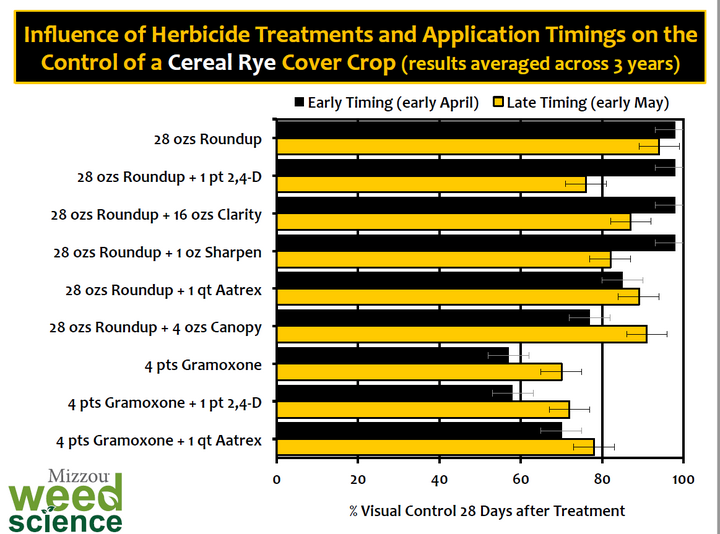A recent survey from the 2016 Soybean Management Field Days (Chapman, Cordova, Orchard, and Schuyler) and the 2016 UNL Water and Crops Field Day (North Platte) asked producers whether they incorporate cover crops as part of their cropping systems and their primary reasons for doing so. Approximately one-third of participants indicated they use cover crops to some extent for:
- erosion control,
- increased organic matter,
- soil health,
- nitrogen management,
- improved water retention, and
- weed suppression.
With a drier than normal winter and minimal precipitation so far in 2017, producers are encouraged to terminate cover crops earlier than the minimum recommendation for cropping systems where soil moisture can become a limiting factor.
With the recent rains and above-average temperatures, fall-planted cereal rye is growing rapidly (Figure 1) and termination needs to occur soon in cropping systems where soil moisture can become a limiting factor.
Cereal Rye Cover Crop Termination
According to the NRCS Cover Crop Termination Guidelines for non-irrigated cropland, fall-planted cereal rye cover crop should be terminated at or before planting in eastern Nebraska (Figure 2). In the western two-thirds of the state, cover crops should be terminated at least 15 days before planting. For irrigated cropping systems, cover crops should be terminated before crop emergence.
The NRCS guidelines were developed to help producers maximize conservation benefits from cover crops, while minimizing crop yield loss by conserving adequate soil water. Because we had a drier than normal winter (2016/2017) and minimal precipitation so far in 2017, producers are encouraged to take a more conservative approach and terminate cover crops before the minimum recommended for cropping systems where soil moisture can become a limiting factor.

Cereal Rye Cover Crop Termination Options
Herbicides
Research conducted in Missouri showed that 28 oz of Roundup (glyphosate) provided satisfactory control of cereal rye (Figure 3). The early termination treatment (early-April) resulted in better control than the later termination treatment (early-May). Glyphosate efficacy on cereal rye decreases when plants reach reproductive stages. The contact herbicide Gramoxone was also tested and was not as effective as glyphosate.

Figure 3. Influence of herbicide treatments and application timings on the control of cereal rye cover crop (results averaged across three years of research in Missouri). Data collected by Professor Kevin Bradley’s research group at the University of Missouri.
Roller-Crimper
According to research conducted in Pennsylvania, roller-crimpers can be used effectively for cereal rye termination after the boot stage (Figure 4). Although they are not commonly used in Nebraska, the use of roller-crimpers is a viable strategy for producers who would like to have additional biomass in the spring before crop planting and use a mechanical strategy rather than herbicides for cover crop termination.

Final Considerations
- If glyphosate is used for cereal rye termination, it should be sprayed when day temperatures are above 55° F and night temperatures are above 40° F. For effective cereal rye control, glyphosate should be applied before the boot stage.
- Contact herbicides such as Gramoxone and Liberty may be used for cereal rye termination; however, they may not provide adequate control if the cereal rye is at boot or later stages. As with any contact herbicide, practices to improve spray coverage will improve efficacy (e.g., medium spray droplet size and higher application rates).
- If glyphosate-resistant marestail is present at termination, adding herbicides such as 2,4-D and/or Sharpen to the tank-mix will assist with marestail control. Respect soybean planting interval when using 2,4-D pre-plant.
- Late termination of cereal rye may reduce the yield potential of the main crop due to:
- excessive soil water use;
- temporary sequestration of plant available nutrients that are critical for the early development of the subsequent cash crop (particularly nitrogen for corn); and
- excessive amounts of residue that can make planting difficult.
- Terminating cereal rye with glyphosate in mid-April seems to be a common and “safe” strategy for Nebraska producers who use fall-planted cereal rye as a cover crop.
- If cover crops are terminated early (early to mid-April), producers may wait to spray their pre-emergence herbicides until planting time. If cover crops are terminated late (e.g., around planting time), producers are encouraged to include pre-emergence herbicides with the termination application.
- Cover crops may suppress troublesome weeds, but typically do not provide adequate weed control alone. Combining cover crops and herbicide programs can become a powerful strategy for weed management.
- excessive soil water use;
- temporary sequestration of plant available nutrients that are critical for the early development of the subsequent cash crop (particularly nitrogen for corn); and
- excessive amounts of residue that can make planting difficult.
For additional herbicide options, please check the Nebraska Extension Guide for Weed, Disease and Insect Management in Nebraska. Always read the herbicide label before application.
Producers are encouraged to visit with their insurance provider when deciding the time for cover crop termination as local rules may be different.

